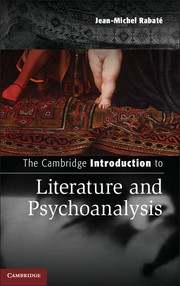Book contents
- Frontmatter
- Contents
- Acknowledgments
- Introduction
- Chapter 1 Freud’s theater of the unconscious
- Chapter 2 Literature and fantasy, toward a grammar of the subject
- Chapter 3 From the uncanny to the unhomely
- Chapter 4 Psychoanalysis and the paranoid critique of pure literature
- Chapter 5 The literary phallus, from Poe to Gide
- Chapter 6 A thing of beauty is a Freud forever
- Chapter 7 From the history of perversion to the trauma of history
- Conclusion
- Keywords and Index of Authors
- Bibliography
- Index
- References
Chapter 6 - A thing of beauty is a Freud forever
Joyce with Jung and Freud, Lacan, and Borges
Published online by Cambridge University Press: 05 September 2014
- Frontmatter
- Contents
- Acknowledgments
- Introduction
- Chapter 1 Freud’s theater of the unconscious
- Chapter 2 Literature and fantasy, toward a grammar of the subject
- Chapter 3 From the uncanny to the unhomely
- Chapter 4 Psychoanalysis and the paranoid critique of pure literature
- Chapter 5 The literary phallus, from Poe to Gide
- Chapter 6 A thing of beauty is a Freud forever
- Chapter 7 From the history of perversion to the trauma of history
- Conclusion
- Keywords and Index of Authors
- Bibliography
- Index
- References
Summary
Gide left us with the question of the specific enjoyment deployed and conveyed by literature. We have seen that most psychoanalytic readings tend to link this enjoyment with the phallus as a symbolic marker of lack, hence of desire, whereas the later Lacan insists on an absolute and transgressive jouissance. These interpretations attempt to situate enjoyment in relation with letters, either as literal letters (the “literariness” of literature or its literalness), or as allegorical letters, like the letters whose sum constitutes the essence of a “man of letters.” The dual nature of the letter as opening up to absolute enjoyment and as constituting a personal myth of the author can be condensed in a symptom. This notion should lead us to James Joyce, who became for Jacques Lacan the “symptom of literature,” whereas a little earlier he had been presented by Carl Gustav Jung as symptomatic of a modern tendency toward the splitting of consciousness – in other words, of schizophrenia. I will begin this chapter with a discussion of Jung’s reading of Joyce’s works to assess the main difference between Jung and Freud in terms of sexual dynamics. I will end with two parallel interpretations of Joyce’s figure as a man of letters, one by Lacan – closer to Freud but with a tendency to overlap with Jung’s theses – and the other by Jorge Luis Borges – definitively closer to Jung. Joyce will serve as a “strange attractor” for a variety of psychoanalytic discourses about literature, whose enjoyment has been enacted in advance by the Irish writer’s very signature.
Jung’s reading of Ulysses
There is a hushed silence in the abundant secondary literature about Joyce concerning Jung’s notoriously bad-tempered essay on Ulysses. He published it in 1932, ten years after the novel’s publication, at a time when Joyce’s book was hailed as a modern masterpiece, receiving quasi-universal critical acclaim. It is rare to see a famous psychoanalyst, who by that time had founded his own school, rant for more than twenty pages about a novel that he claims not to like and not to understand and whose main interest comes from the fact that it looks very much like the ravings of schizophrenics. One must know the genealogy of the complex links between Jung and Joyce to make better sense of this odd diatribe.
- Type
- Chapter
- Information
- The Cambridge Introduction to Literature and Psychoanalysis , pp. 150 - 173Publisher: Cambridge University PressPrint publication year: 2014

